The military cemeteries of the France 1940 campaign
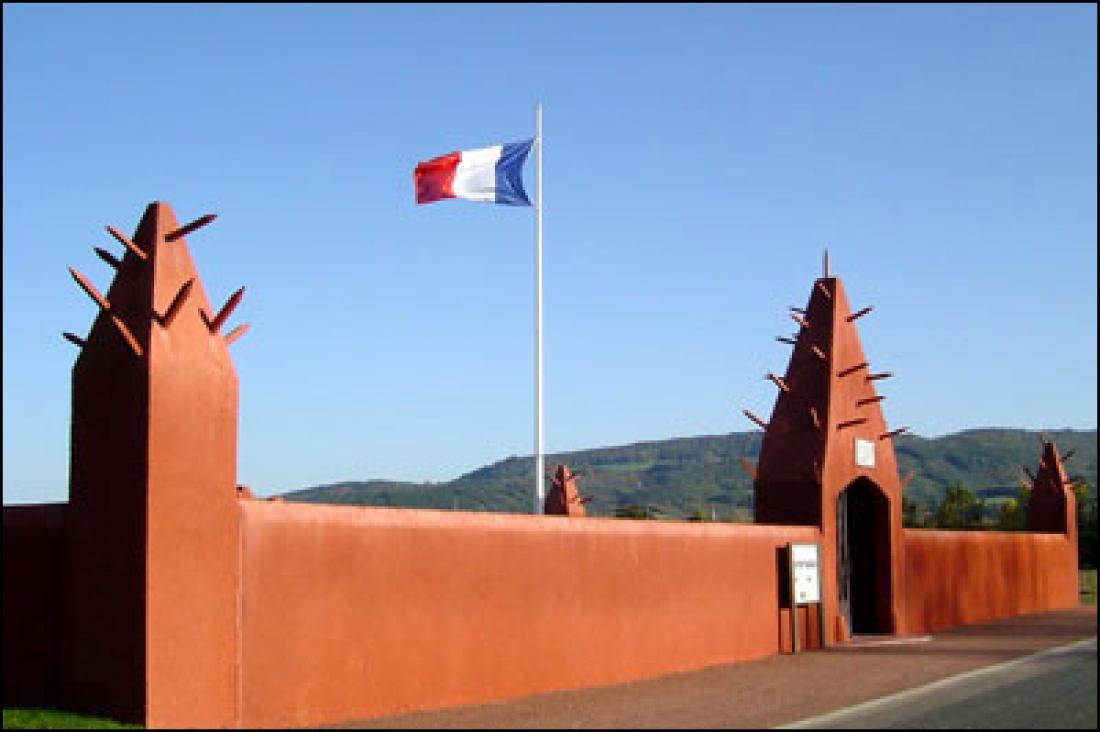
Burials in the 1940s
The dead in the France campaign were abandoned on the very fields of combat. While some were quickly buried by local authorities or individuals, most remained unburied lying where they had fallen without any tomb.
The harshness of the fighting (losses comparable to the hardest-fought battles of the first world war), the rapidly shifting front due to enemy incursions, the retreat of French troops, the desolation of areas evacuated or deserted by civilians, the German occupation, all these conditions did not enable systematic burial of French fighters who died in combat. On some points on the front, French health corps buried the wounded who died during care by creating small cemeteries such as the Zuydcoote sanatorium (aid station in June 1940) or the area behind the armies near military hospitals, such as Villeurbanne-La Doua near Lyon or Sainte-Anne-d'Auray (Morbihan). Sometimes, German units buried the dead, especially those at the Fort des Dunes in Leffrinckoucke, or those at the L'Ouvrage de La Ferté (Ardennes).
In 1941, the Moselle department was cleared of mines by prisoners of war, lieutenant Robardet and staff sergeant Peupin along with a few men. In the course of this mission they discovered the bodies of the defenders lying exactly where they fell in destroyed bunkers, pounded trenches, case mates disembowelled by bombs or burnt by flame-throwers. Most of these deaths were soldiers from the Coloniale and fortress infantry regiments. The lieutenant then proposed to the German authorities to use his team to give them a dignified burial. The work lasted two years and more than 2,500 bodies were identified and buried.
Searching for and burying the bodies in the small municipal cemeteries was made easier across the entire front as refugees returned to their villages and normal daily life resumed. Thus, in 1941, in the Ardennes, the inhabitants of Villy exhumed the bodies summarily buried by the enemy, i.e. troops from the Ouvrage de La Ferté garrison and especially Coloniaux troops from the 3rd DIC who died in the sector. In April 1942, they found another 307 bodies in Malandry, in the Neudan and Inor woods, in Olizy-sur-Chiers and these were buried in the communal war cemetery created a year earlier, laid out in individual graves or in the ossuary which houses 138 unknown soldiers. In 1941 in Haubourdin near Lille, the municipality set up a small cemetery where the bodies of the defenders were grouped.
The national grouping cemeteries
In accordance with the law decrees of 22 February, 1940, 19 October 1946 and 21 March 1950 relating to burials, restitution of bodies to families, grouping of tombs, after the war the Ministry of Veteran Affairs began vast operations to ”pay a dignified tribute to the memory of those who died for France in 1939-1945”. From 1946, the bodies were returned to the families who so requested.
Remains that were not returned were reburied either in 1914-1918 national cemeteries where they formed ”1940” tomb sections for example in Verdun, Bras, Dugny (Meuse), Ambleny, Champs, Soupir, Vauxaillon (Aisne), Beauvais (Oise), La Ferme de Suippes, Sainte-Menehould, in the Marne, La Targette (Pas-de-Calais), Zuydcoote (North), etc.
Tombs were maintained in British cemeteries for example the 218 tombs of the 2nd DLC in Saint-Valery-en-Caux (Somme). Other bodies remained in cemeteries abroad, in Belgium (in Chastre, created in 1969), Luxembourg, the Netherlands and Norway.
Grouping operations and inaugurations of new national cemeteries extended from 1950 to around 1975.
Large grouping cemeteries were put in place in Floing (Ardennes), Cambronne-lès-Ribecourt (Oise), Condéfolie (Somme), in Fleury-les-Aubrais (Loiret).
These exhumations concerned thousands of communes. Many small cemeteries were abandoned, except when some municipalities expressed the intention of maintaining the graves of their defenders: Villy-La Ferté, refurbished and inaugurated in 1962, La Horgne (Ardennes) where Spahis were buried, Marc¬kolsheim (Bas-Rhin) where the dead from the 42e RIF are buried, Maubeuge and Avesnes-sur-Helpe, in the North.
The unknown soldier in 1939-1940
On July 16, 1950, at the initiative of the association ”Les Fils des Tués” (The sons of the slain) and in the presence of Mssrs Guy Mollet, vice-president of the Council, and Jacquinot, Minister of Veteran Affairs, an unknown soldier brought solemnly to the national cemetery of Notre-Dame-de-Lorette in Ablain-Saint-Nazaire (Pas-de-Calais) and was reburied in one of the vaults of the Tour-Lanterne crypt. His remains had been chosen among 27 French unidentified soldiers killed in May-June 1940 and exhumed for this purpose from the L'Ouest graveyard in Calais.
On 20 June 1940, the Mayor of Chasselay (Rhône) buried the bodies found on the battle field.
In 1942, Mr Marchiani, Secretary-General of the Rhône Office for maimed veterans and war victims, had privately acquired the land on which the Germans massacred their Senegalese prisoners. He had a 'Tata' built on this site, i.e. a typical Senegalese cemetery, enclosed by walls, a sacred enclosure for the remains of the warriors. He then alone undertook the difficult task of searching for the bodies and exhumed 188 officers and soldiers, mainly from the 25th RTS regiment and had them reburied in the Tata cemetery.
The inauguration took place on November 8, 1942, in the presence of Mr Ngalandou Diouf, Senegalese MP and numerous French personalities.
The main cemeteries
The battle of Belgium
In The Netherlands:
VREDENHOF: 21 bodies...................................
In Belgium
ANTWERP: 23 bodies.
CHASTRE: 1,058 bodies
The battle of the Ardennes
National cemetery:
FLOING (Ardennes): 1,952 bodies, 1.9 hectare. 266 graves have a Muslim monument
Military sections in communal cemeteries:
LA HORGNE (Ardennes): 40 bodies
SEDAN (Ardennes): 33 bodies
The battle of the North
National cemeteries:
HAUBOURDIN (North): 1,960 bodies including 178 Soviet. 707 graves have a Muslim monument. 7,425 m2.
LEFFRINCKOUCKE (North): 190 bodies. 1,770 m2.
1940 sections in the national cemeteries of 1914-1918:
ZUYDCOOTE (North): 916 bodies from 39-45, 1,342 bodies from 14-18. An ossuary. 7,230 m2. LA TARGETTE (Pas-de-Calais): 818 bodies from 39-45, 11,323 bodies from 14-18. Three ossuaries. 4.5 hectares
Military sections in communal cemetery
AVESNES-SUR-HELPE (North): 62 bodies.
MAUBEUGE (North): 32 bodies.
FEBVIN-PALFART (Pas-de-Calais): 117 bodies.
The battles of L'Aisne and Champagne
AMBLENY (Aisne): 567 bodies from 39-45, 10,674 bodies from 14-18. Four ossuaries. 3.6 hectares.
CHAMPS (Aisne): 186 bodies from 39-45, 2,809 bodies from 14-18. Two ossuaries. 2 hectares.
FLAVIGNY-LE-PETIT (Aisne): 431 bodies from 39-45, 2,736 bodies from 14-18. Two ossuaries. 1.3 hectare.
SAINT-QUENTIN (Aisne): 207 bodies from 39-45, 5,066 bodies from 14-18. Two ossuaries. 1.8 hectare.
SOUPIR No 2 (Aisne): 544 bodies from 39-45, 2,251 bodies from 14-18. An ossuary. 1.3 hectare.
VAUXAILLON (Aisne): 169 bodies from 39-45, 1,909 bodies from 14-18. Two ossuaries. 8,911 m2.
FERE-CHAMPENOISE (Marne): 161 bodies from 39-45, 5,733 bodies from 14-18. One ossuary. 1.6 hectare.
LA FERME DE SUIPPES (Marne): 1,911 bodies from 39-45, 7,349 bodies from 14-18. Two ossuaries. 4.7 hectares.
SAINT-THOMAS-EN-ARGONNE (Marne): 88 bodies from 39-45, 8,024 bodies from 14-18. Two ossuaries. 2.4 hectares.
SAINTE-MENEHOULD (Marne): 215 bodies from 39-45, 5,755 bodies from 14-18. Eight ossuaries. 2 hectares.
VITRY-LE-FRANÇOIS (Marne): 62 bodies from 39-45, 4,067 bodies from 14-18. One ossuary. 8,612 m2.
The battle of the Somme
National cemetery:
CONDE-FOLIE (Somme): 3,279 bodies. One ossuary. 12,818 m2. 829 graves have a Muslim monument.
1940 section in a British cemetery:
SAINT-VALERY-EN-CAUX (Seine Maritime): 218 bodies.
The battle of L'Oise
National cemetery:
CAMBRONNE-LES-RIBECOURT (Oise): 2,129 bodies from 39-45, 126 bodies from 14-18. 9,780 m2. 171 graves have a Muslim monument.
1940 sections in the national cemeteries of 1914-1918:
BEAUVAIS (Oise): 95 bodies from 39-45, 1,091 bodies from 14-18. One ossuary. 5,655 m2. Section with 164 allies from 39-45.
VERBERIE (Oise): 41 bodies from 39-45, 2,559 bodies from 14-18. Two ossuaries. 6,518 m2.
The battles of the East
1940 section in the national cemeteries of 1914-1918:
AVOCOURT (Meuse): 49 bodies from 39-45, 1,847 bodies from 14-18. 1.2 hectare.
BELLERAY (Meuse): 111 bodies from 39-45, 4,123 bodies from 14-18. 7,217 m2.
BRAS (Meuse): 151 bodies from 39-45, 6,386 bodies from 14-18. Two ossuaries. 3.2 hectares.
CHATTANCOURT (Meuse): 27 bodies from 39-45, 1,697 bodies from 14-18. 1.5 hectare.
DUGNY (Meuse): 135 bodies from 39-45, 1,836 bodies from 14-18. One ossuary. 1.5 hectare.
VERDUN BEVAUX (Meuse) :485 bodies from 39-45, 3,107 bodies from 14-18. 2.3 hectares.
VERDUN FAUBOURG PAVE (Meuse): 602 bodies from 39-45, 4,906 bodies from 14-18. 1.9 hectare.
ALTKIRCH (Haut-Rhin): 32 bodies from 39-45, 1,749 bodies from 14-18. Two ossuaries. 5,153 m2.
ORBEY WETTSTEIN (Haut-Rhin): 58 bodies from 39-45, 3,534 bodies from 14-18. Two ossuaries. 9,902 m2.
GRANDFONTAINE (Bas-Rhin): 24 bodies from 39-45, 300 bodies from 14-18. Two ossuaries. 2,468 m2.
PLAINE (Bas-Rhin): 142 bodies from 39-45, 1,018 bodies from 14-18. Three ossuaries. 3,562 m2.
BADONVILLER (Meurthe-et-Moselle): 28 bodies from 39-45, 2,563 bodies from 14-18. Two ossuaries. 7,900 m2.
NEUFCHATEAU (Vosges): 47 bodies from 39-45, 836 bodies from 14-18. 6,206 m2.
Military section in communal cemetery:
BRUYÈRES (Vosges): 22 bodies.
The fighting at the Maginot line
National cemetery:
VILLY-LA-FERTE (Ardennes): 105 bodies. One ossuary. 334 m2. 1940 tombs are in the national cemeteries of HAGUENAU and STRASBOURG (Bas-Rhin), SARREBOURG-BUHL, METZ-CHAMBIERE (Moselle), CERNAY (Haut-Rhin).
Military sections in communal cemeteries:
BITCHE (Moselle): 21 bodies.
PHALSBOURG (Moselle): 33 bodies.
MARCKOLSHEIM (Bas-Rhin): 25 bodies.
The fighting in the Rhône
National cemetery:
CHASSELAY (Rhône): 196 bodies. 785 m2.
The fighting in the Loire
National cemetery:
FLEURY-LES-AUBRAIS (Loiret): 2,881 bodies from 39-45, 635 bodies from 14-18. One ossuary. 2.5 hectares. 870 graves have a Muslim monument.
The battle of the Alps
Military section in communal cemetery:
The interior zone
Nice (Alpes-Maritimes): 631 bodies from 39-45 including some killed from 1940.
National cemeteries:
VILLEURBANNE LA DOUA (Rhône): 2,565 bodies from 39-45, 3,348 bodies from 14-18. 8.5 hectares.
SAINTE-ANNE-D'AURAY (Morbihan): 1,369 bodies from 39-45, 701 bodies from 14-18. Two ossuaries. 1.7 hectare.
These two cemeteries received the dead from 1940 who died during their stay in the military hospitals in the Interior zone.
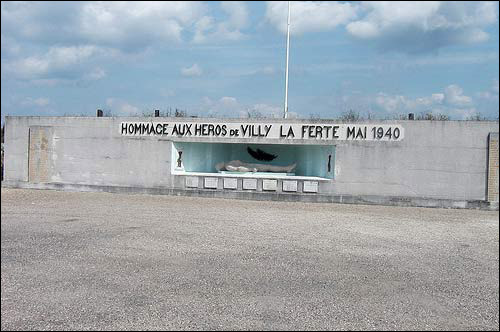
Le mémorial de Villy la ferté. Source : Mémorial du fort de Villy-la-Ferté
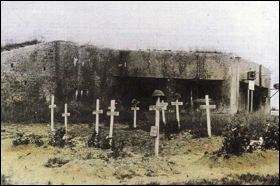
Cimetière Marckolsheim. Un petit cimetière rassemblant les corps de soldats français tombés près de Marckolsheim. Source : Mémorial de la ligne Maginot de Marckolsheim
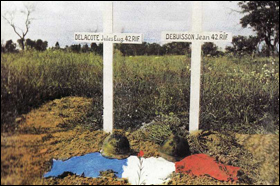
Cimetière Marckolsheim. A l'occasion du 14 juillet, les habitants des villages environnants ont confectionné un drapeau tricolore qui décore la tombe de deux soldats du 42e RIF. Source : Mémorial de la ligne Maginot de Marckolsheim
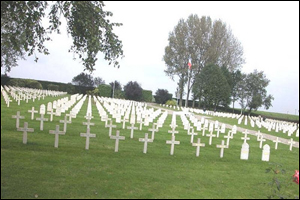
Le cimetière de Chastre. Source : D.R.
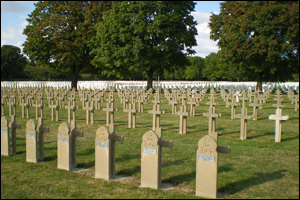
La ferme de Suippe. Source : Philippe Crozet
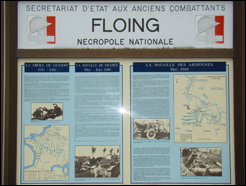
Floing. Source : site et forum des Bataillons de Chasseurs et des Diables Bleus du 30°. Photo Vincent Bourgeois
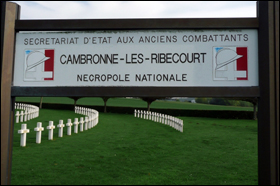
Cambronne les Ribecourt. Source : Josianne Ferret
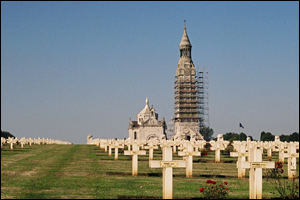
La tour Lanterne. Source : Jean-Pierre Le Padellec
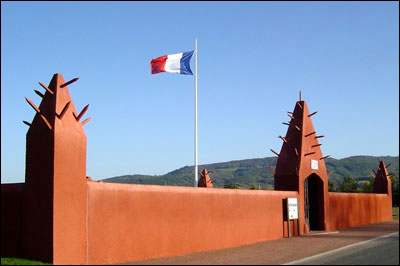
Le tata sénégalais de Chasselay. Source : Richard Monléon SGA/DMPA
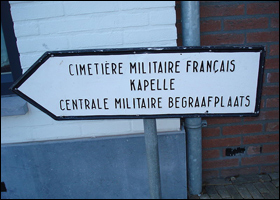
Kapelle panneau indicateur cimetière français, auteur Havang. Source : Licence Creative Commons
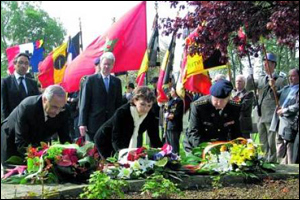
Chastre 17 mai 2010 Commémoration de la bataille de mai 1940. Source : DR

